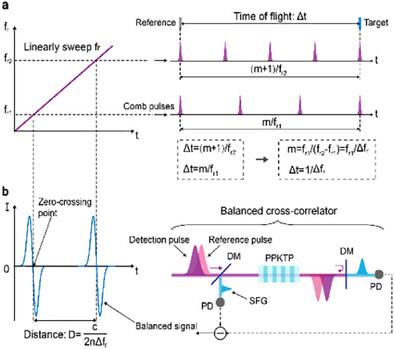使用单频调制电光梳的平衡相互关系进行快速和精确的距离测量
IF 10
1区 物理与天体物理
Q1 OPTICS
引用次数: 0
摘要
超快速,高精度的距离计量是先进的科学研究和实际应用的关键。然而,当前的光探测和测距技术难以同时实现高测量速度、精度和大的无模糊范围。本文提出了一种基于重复调频飞秒电光梳和平衡非线性互相关检测的飞行时间光学测距技术。在这种方法中,目标距离被确定为梳重复周期的整数倍。通过快速扫描梳重复频率,实现了500 ns内的绝对距离测量和单脉冲分辨率(对应于172 MHz的刷新率)的实时位移跟踪。此外,该系统的最终测距精度为5 nm(积分时间为0.3 s)。该方法独特地集成了纳米级精度、兆赫兹级刷新率和理论上无限模糊范围,同时还支持多目标检测。这些进步为结构健康监测、工业制造和卫星编队飞行等新兴应用中的高速、高精度测距系统铺平了道路。本文章由计算机程序翻译,如有差异,请以英文原文为准。

Rapid and Precise Distance Measurement Using Balanced Cross‐Correlation of a Single Frequency‐Modulated Electro‐Optic Comb
Ultra‐rapid, high‐precision distance metrology is critical for both advanced scientific research and practical applications. However, current light detection and ranging technologies struggle to simultaneously achieve high measurement speed, accuracy, and a large non‐ambiguity range. Here, a time‐of‐flight optical ranging technique based on a repetition‐frequency‐modulated femtosecond electro‐optic comb and balanced nonlinear cross‐correlation detection is presented. In this approach, a target distance is determined as an integer multiple of the comb repetition period. By rapidly sweeping the comb repetition frequency, absolute distance measurements within 500 ns and real‐time displacement tracking at single‐pulse resolution (corresponding to a refresh rate of 172 MHz) are achieved. Furthermore, the system attains an ultimate ranging precision of 5 nm (with 0.3 s integration time). This method uniquely integrates nanometer‐scale precision, megahertz‐level refresh rates, and a theoretically unlimited ambiguity range within a single platform, while also supporting multi‐target detection. These advances pave the way for high‐speed, high‐precision ranging systems in emerging applications such as structural health monitoring, industrial manufacturing, and satellite formation flying.
求助全文
通过发布文献求助,成功后即可免费获取论文全文。
去求助
来源期刊
CiteScore
14.20
自引率
5.50%
发文量
314
审稿时长
2 months
期刊介绍:
Laser & Photonics Reviews is a reputable journal that publishes high-quality Reviews, original Research Articles, and Perspectives in the field of photonics and optics. It covers both theoretical and experimental aspects, including recent groundbreaking research, specific advancements, and innovative applications.
As evidence of its impact and recognition, Laser & Photonics Reviews boasts a remarkable 2022 Impact Factor of 11.0, according to the Journal Citation Reports from Clarivate Analytics (2023). Moreover, it holds impressive rankings in the InCites Journal Citation Reports: in 2021, it was ranked 6th out of 101 in the field of Optics, 15th out of 161 in Applied Physics, and 12th out of 69 in Condensed Matter Physics.
The journal uses the ISSN numbers 1863-8880 for print and 1863-8899 for online publications.

 求助内容:
求助内容: 应助结果提醒方式:
应助结果提醒方式:


